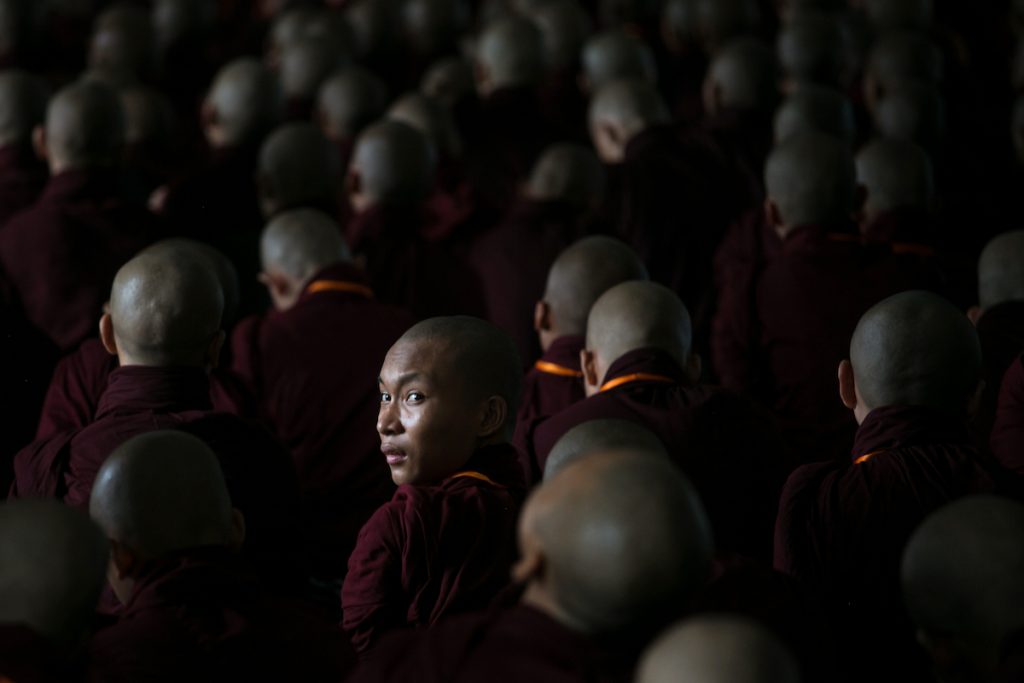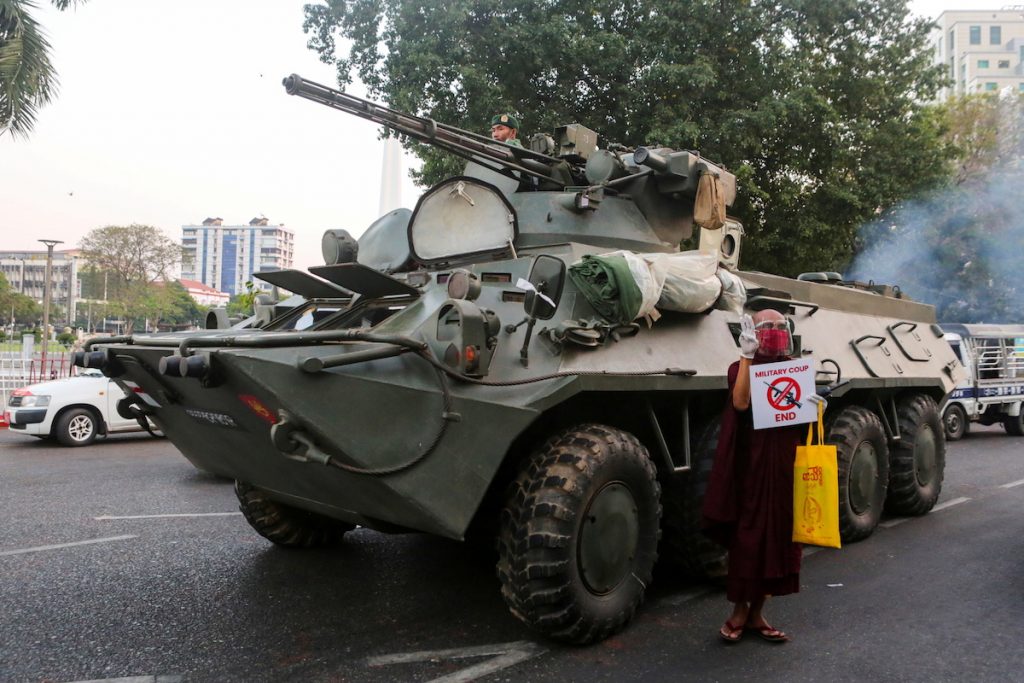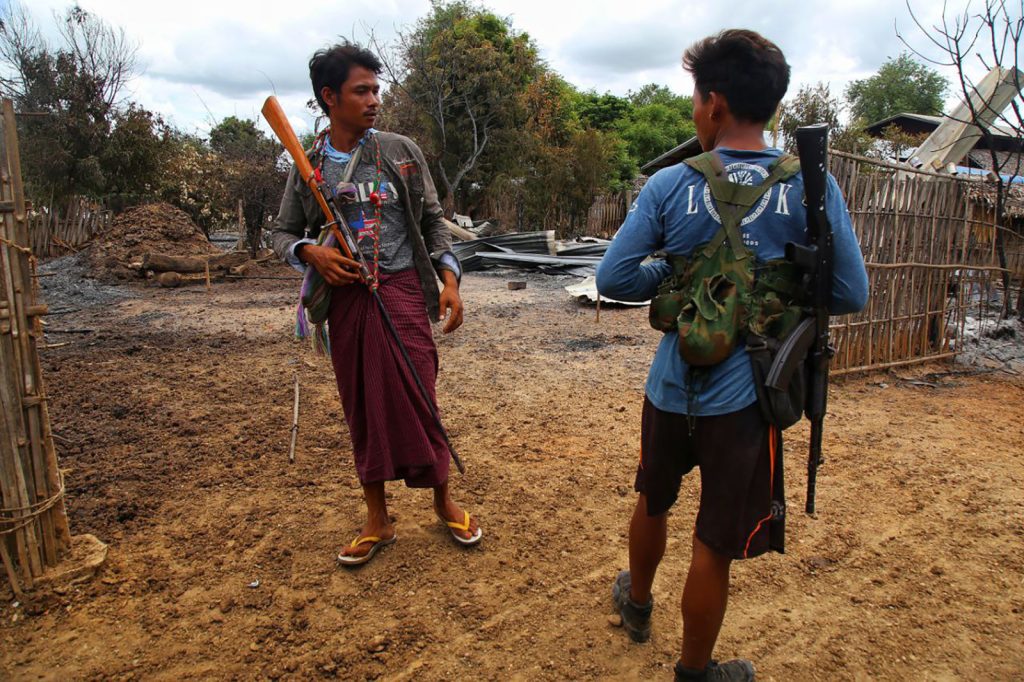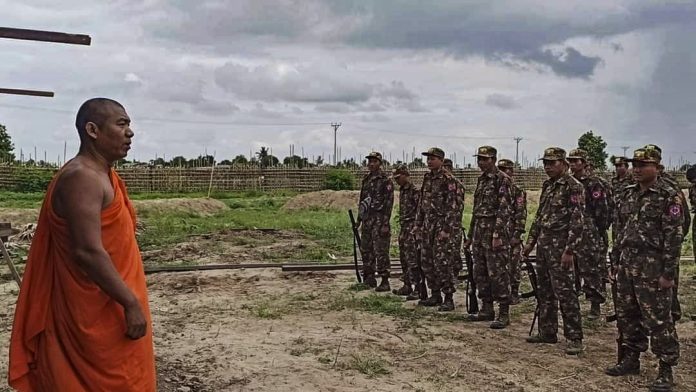An ultranationalist Buddhist monk is leading the charge against Myanmar’s armed rebellion in Sagaing region for the military regime, establishing a network of pro-junta militias using a combination of violent coercion and fear-mongering.
While you won’t find him on any list of sanctions targeting the junta and its cronies for their repression of the country’s opposition, Warthawa is well known in Sagaing, where the military has faced some of the strongest resistance to its rule since its February 2021 coup.
The stern-looking 40-year-old monk with broad shoulders and wide-set eyes made a name for himself in Sagaing’s Kanbalu township, where he previously served as the abbot of a temple in the Muslim-majority village of Hmaw Taw – a tract where only 10% of the 500 households observe Myanmar’s national religion of Buddhism.
He later became a former leader, or “sayadaw,” of the country’s now-defunct Ma Ba Tha network of extremists, who residents of the region told Radio Free Asia stoked fears of an assault on Buddhism to gain followers.
“These monks made people delusional through the use of religion, but they are evil monks,” said a resident of neighboring Taze township, who spoke on condition of anonymity, citing fear of reprisal.
Despite a ban of the Ma Ba Tha under Myanmar’s former National League for Democracy government, sources in Sagaing say that since August 2021, Warthawa has used the support of the military regime to push his nationalist agenda. He’s also helped form “Pyu Saw Htee” militias that assist the junta in its offensive against the region’s People’s Defense Force paramilitary groups and armed ethnic groups.
“After the military coup, [Warthawa] supported the military and the USDP,” the Taze resident said, referring to the pro-military Union Solidarity and Development Party.
He said that the monk and his followers have made the Pyu Saw Htee “much stronger,” prompting a recent rash of revenge killings of civilians with suspected links to the PDF in response to attacks on the military.
A PDF member in Kanbalu who also declined to be named told RFA that Warthawa “uses religion as his weapon” to turn the largely uneducated population of rural Sagaing against the armed resistance.
“He deludes the people, telling them that our country will become part of [neighboring] India [if they do not fight],” he said.
“He first built the Pyu Saw Htee forces. Then, when they became strong, even the NLD supporters dared not oppose them,” he said. “Some of them fled from their villages. Those who remain are recruited by force. One person must join their forces from each household and then these groups serve as the village defense.”

Expanding militia network
Sources say Warthawa has seen significant recruiting success in Kanbalu and Taze, as well as the township of Kyunhla – three areas where there is already strong support amongst villagers for the military and its political party, the USDP.
But reports indicate he is also working to expand the network throughout Sagaing, where at least 77 pro-junta militia groups are currently operating, according to a confidential report by the Northwest Military Command, leaked to social media in March 2022.
That same month, a video went viral on social media, purportedly showing members of the Ma Ba Tha on a “tour” of several pro-junta villages in Sagaing in support of forming Pyu Saw Htee units. The video appeared to show the monks helping to train people and delivering Buddhist sermons.
In one clip, Warthawa and two other Ma Ba Tha sayadaws Wira Raza and Pandita appear to be holding guns in their hands and telling residents that the PDF fighters were killing people and setting fire to villages.
Sources told RFA at the time that the footage was filmed on Feb. 27 at the Yadanar Kan Myint Htei Monastery during a Pyu Saw Htee training camp graduation ceremony in Taze township’s Kabe village. They confirmed that pro-junta monks had been “carrying guns” and “taking part in some of the fighting” in the region.

‘They call us bald-heads’
A more recent video, filmed at a monastery in western Kanbalu’s Kyun Lel village and viewed by RFA, showed members of a Pyu Saw Htee group telling residents that they must take up arms as part of an effort to “build peace” and defend the area from PDF fighters who are “insulting and destroying our country, our people, and our religion.”
“They kill their own people just because they hold different views. They call monks venerable when they need us, but when they don’t like us, they call us bald-heads,” says one monk-turned-militia member. “The PDF is a group of inhumane people with an animal mindset.”
“Therefore, you, my comrades, are taking up arms to defend your village, your region and your country. Isn’t that so?”
Local media outlet Myanmar Now reported that in October, Warthawa led a group of monks and gunmen to Kanbalu’s Ngar Toet village, where they ordered residents of the tract’s 250 households into the local monastery before one of the armed men fired his weapon into air and warned them they would be shot if they tried to leave.
Warthawa oversaw the selection of 150 men to attend a two-week training to prepare them for joining the Pyu Saw Htee, held at the same monastery. Nearly all who were chosen went to the training “by force,” the report said, quoting one resident whose name was among those called.
The resident fled the village with his family and went into hiding, but Myanmar Now said junta troops killed one person who attempted to run away – a former campaign organizer for the ousted NLD – and recaptured another, whose condition is currently unknown.
Warthawa has also used the military to build up his Pyu Saw Htee network by offering incentives to potential recruits. Myanmar Now said the junta provided Warthawa with nearly U.S.$2,000 in cash earmarked for disaster relief, local development, and monasteries to buy food for Pyu Saw Htee members in Kanbalu and Taze in October. Villagers familiar with the militias in the townships said members are provided with free uniforms and paid U.S.$80 monthly, while leaders receive a salary of U.S.$100.
Other residents told RFA that there are currently around 400 members of the Pyu Saw Htee in Taze, all of whom have been equipped with weapons issued to them by the junta’s Northwest Military Command based in Monywa, Sagaing’s largest city.

‘No major sins’
While Warthawa initially established the Pyu Saw Htee groups in western Kanbalu with the vow that they would only be used for “village protection,” sources told RFA that he had since ordered them to join military columns throughout the township.
In the nearly two years since the coup, Pyu Saw Htee groups fighting alongside the military in Taze have arrested or killed at least 77 civilians, burned down 83 villages, and forced more than 16,000 people to flee their homes, the residents said.
In November and December alone, the Pyu Saw Htee groups under Warthawa’s command killed 30 civilians and torched more than 1,100 houses in 21 villages in the three townships, they said.
In an interview with Myanmar in June, Warthawa defended his attacks on villages he claims to be aligned with the armed resistance movement, claiming that he was acting in the spirit of “angry benevolence.”
When asked about his role in the conflict, a former Ma Ba Tha monk named Pauk Ko Taw told RFA that Warthawa’s actions are “righteous” and that he “doesn’t support killing people.”
“He is just working as a monk for building peace in Sagaing’s Kanbalu township, that’s why he organized [the groups] for peace making,” he said. “We Buddhist monks need to organize people to stay peaceful and united and preach harmony to our ethnic groups. Warthawa has not committed any major sins … in Buddhism.”
‘Training killers’
But a Sagaing-based monk characterized Warthawa’s actions as “far from acceptable” for a member of the clergy.
Junta leader Senior Gen. Min Aung Hlaing “abuses his power, torturing and killing the people and burning their villages through military might,” said the monk, who requested anonymity.
“Since Warthawa is training such killers in the Pyu Saw Htee, what he is doing is not in accordance with the codes of Buddhist monks in any way.”
A monk in Mandalay agreed that Warthawa is abusing his role as a monk to further his own agenda. “We Buddhist monks are prohibited from even using harsh words against others or cursing, let alone killing or taking up arms,” the monk said.
“Monks are the object of veneration and worship for the people and we have to preserve morality as the model for the people. Taking up arms like he has is completely wrong and such monks can no longer be considered followers of Buddhism.”
The monk told RFA that it is the responsibility of the State Sangha Maha Nayaka Committee, which oversees the nation’s Buddhist clergy, to discipline such wrongdoings, but said that in this case, “they are turning a blind eye.”
Multiple attempts by RFA to contact Warthawa for this report went unanswered, as did inquiries made to the Yangon-based State Sangha Maha Nayaka Committee.









